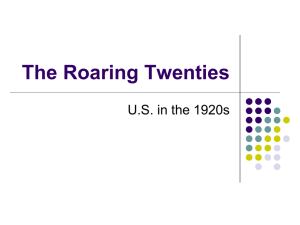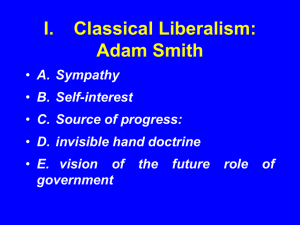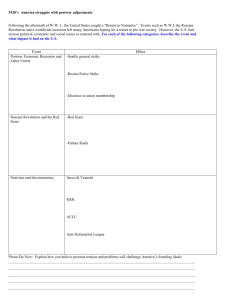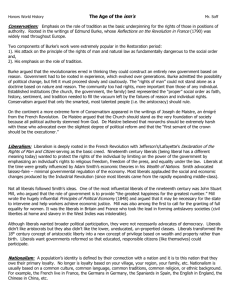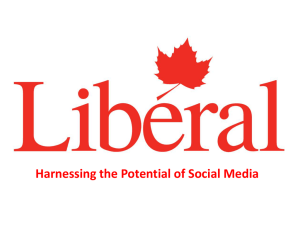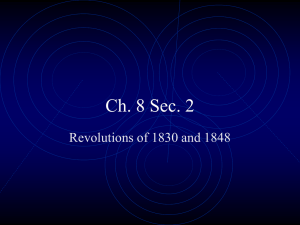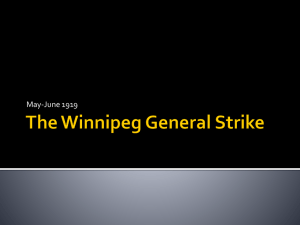Great Depression - Communism & Socialism
advertisement
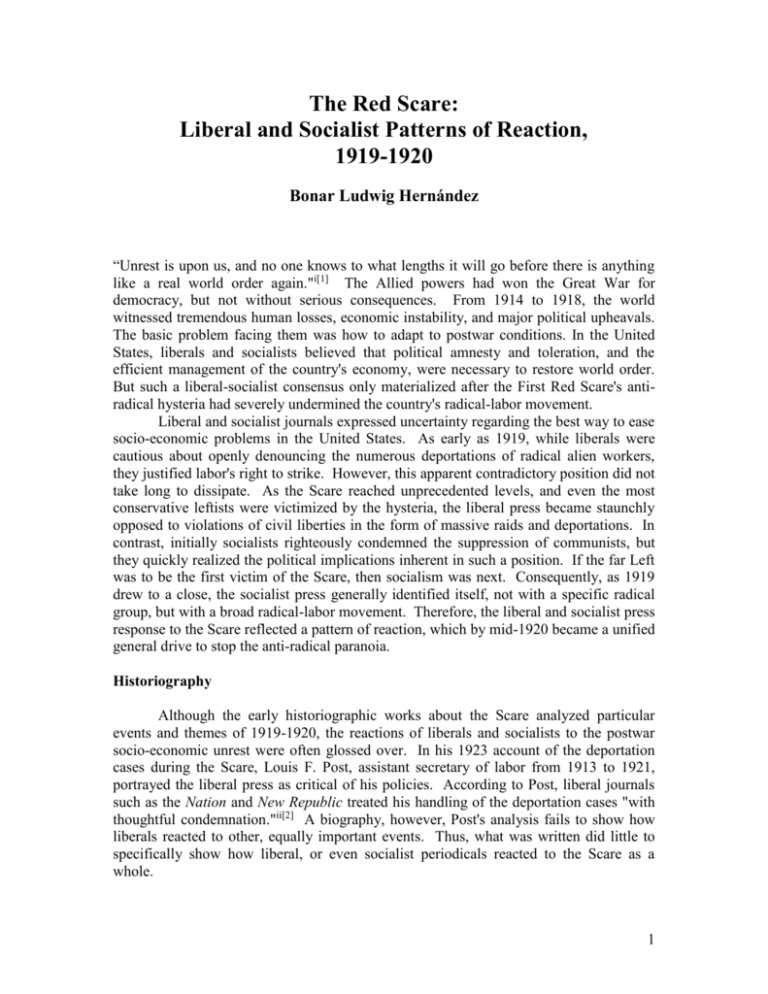
The Red Scare: Liberal and Socialist Patterns of Reaction, 1919-1920 Bonar Ludwig Hernández “Unrest is upon us, and no one knows to what lengths it will go before there is anything like a real world order again."i[1] The Allied powers had won the Great War for democracy, but not without serious consequences. From 1914 to 1918, the world witnessed tremendous human losses, economic instability, and major political upheavals. The basic problem facing them was how to adapt to postwar conditions. In the United States, liberals and socialists believed that political amnesty and toleration, and the efficient management of the country's economy, were necessary to restore world order. But such a liberal-socialist consensus only materialized after the First Red Scare's antiradical hysteria had severely undermined the country's radical-labor movement. Liberal and socialist journals expressed uncertainty regarding the best way to ease socio-economic problems in the United States. As early as 1919, while liberals were cautious about openly denouncing the numerous deportations of radical alien workers, they justified labor's right to strike. However, this apparent contradictory position did not take long to dissipate. As the Scare reached unprecedented levels, and even the most conservative leftists were victimized by the hysteria, the liberal press became staunchly opposed to violations of civil liberties in the form of massive raids and deportations. In contrast, initially socialists righteously condemned the suppression of communists, but they quickly realized the political implications inherent in such a position. If the far Left was to be the first victim of the Scare, then socialism was next. Consequently, as 1919 drew to a close, the socialist press generally identified itself, not with a specific radical group, but with a broad radical-labor movement. Therefore, the liberal and socialist press response to the Scare reflected a pattern of reaction, which by mid-1920 became a unified general drive to stop the anti-radical paranoia. Historiography Although the early historiographic works about the Scare analyzed particular events and themes of 1919-1920, the reactions of liberals and socialists to the postwar socio-economic unrest were often glossed over. In his 1923 account of the deportation cases during the Scare, Louis F. Post, assistant secretary of labor from 1913 to 1921, portrayed the liberal press as critical of his policies. According to Post, liberal journals such as the Nation and New Republic treated his handling of the deportation cases "with thoughtful condemnation."ii[2] A biography, however, Post's analysis fails to show how liberals reacted to other, equally important events. Thus, what was written did little to specifically show how liberal, or even socialist periodicals reacted to the Scare as a whole. 1 Later and more in-depth studies about the period treated liberal and socialist press reactions as two distinct forces. That is, scholars often approached the liberal and socialist points of view separately. For instance, in his 1946 study of the Criminal Syndicalism Law of California, Woodrow Whitten concentrates on the reactions of the socialist and the general press. He maintains that toward the end of 1919, the California socialist press slowly joined the ranks of the Communist Labor Party (CLP). Best represented by the Oakland World, socialist newspapers defended the communists' right to organize and dissent. But with the advent of the heavy suppression of communists in early 1920, Whitten argues, socialist newspapers like the World refrained from further declarations specifically addressing the communist suppression.iii[3] He neglects to mention, however, how liberal journals responded to the Scare hysteria. On the other hand, during the early 1950s scholars of the liberal establishment entirely left out the socialist reaction. David W. Noble, in his 1951 article about the New Republic and the progressive movement, tells us that postwar liberals found themselves trapped between the forces of labor and government. Specifically, he asserts that although the New Republic opposed anti-radical paranoia, it remained skeptical about the radical movement in general. Moreover, as the classless social order that the New Republic dreamed of became impossible, liberals turned their attention to individualistic and religious concerns. In this sense, the editors of the New Republic were only superficially committed to the protection of civil liberties of radical workers, even during the height of the Scare. As in the case of Whitten, Noble fails to mention whether liberals reacted in the same way as socialists to the 1919-1920 hysteria.iv[4] By the mid-1950s, in contrast to these one-dimensional accounts, historians began to draw connections between the reactions of liberal and socialist journals. In his analysis of the national Scare hysteria, Robert K. Murray argues that radical and liberal journals expressed similar points of view. He stresses this similarity, not because liberals and radicals held the same political views, but because at one point patriotic organizations classified both of them as dangerous to the national security of the country. Indeed, the American Defense Society, claiming that they were revolutionary, carried out a propaganda campaign against the Nation and New Republic.v[5] Murray's argument suggests why in early 1920 liberals reacted by mobilizing to put an end to the excesses of the Scare. As the 1960s dawned, historians began to write about a postwar liberal-Left coalition. For example, Gilbert C. Fite and H. C. Peterson contend that, as of January, 1920, the editors of the New Republic called liberals to join radicals in a nation-wide amnesty drive. Fite and Peterson, however, neither clarify the motivations of the liberal editorial staff of the New Republic, nor how the journal responded to politicians' handling of the Scare hysteria.vi[6] In his 1963 biography of Attorney General Mitchell Palmer, Stanley Coben depicts a unified liberal-Left as cautious regarding its criticisms of politicians such as Palmer. While the liberal-Left favored amnesty, Coben insists, it did not take a definite stance against Palmer's handling of the numerous deportation cases. As he puts it, in reference to the deportations of December 1919, the Nation and New Republic "wondered whether large scale roundups provided the best weapon against Bolshevism."vii[7] Scholars of the radical movement also continued to document the often ambiguous position of postwar socialists. Ralph E. Shaffer, in his 1962 dissertation about 2 radicalism in California, writes that during 1919, the CLP got control of the socialist press, and used it to defend the first victims of the California Criminal Syndicalism Law. But as anti-radical political action came to affect the communist movement in California, newspapers such as the World disassociated themselves from both the Communist Labor and Communist parties. Thus, Shaffer notes, in 1920 the Socialist Party regained control of the World, which "continued to uphold the communists' right to meet without suppression but disassociated itself from either communist party."viii[8] Likewise, recent approaches to the liberal press' reaction have followed Noble's argument by stressing the self-motivated actions of liberals. In the 1990s, scholars argued that because liberals felt impotent at solving the postwar socio-economic problems, they, though always skeptical, sympathized with the radical-labor movement. Anthony Gengarelly, historian of the liberal-Left, points out how liberals' deep commitment to civil liberties helped put a stop to the Scare hysteria. Nonetheless, he observes, liberals still clung to the notion of a Republican-capitalist system. To be sure, liberals believed that efficient federal government management--though not total control-of the economy was the only way to mitigate socio-economic problems. In this sense, the liberal press' reaction to the Scare reflected liberals' own view about what course of action the government needed to take in order to ease the socio-economic unrest of 19191920.ix[9] I argue that liberal and socialist journals reacted ambiguously to the Scare. I do not intend to answer questions about their political actions and their effect on the outcome of the Scare. To answer those questions a close look at the correspondence and political activities of the editorial staff of each journal I have researched--the Nation and the New Republic, the Liberator and the World--would be necessary. I intend to show the patterns of reaction by liberals and socialists to the First Red Scare. While the Nation and New Republic tried to shift political tolerance as far to the Left as possible, the editors of the Liberator and World generally identified themselves with a broad (radicallabor) movement. I agree with Murray's assertion that as the effects of hysteria became more serious, liberals and socialists became closer, not on philosophical terms, but in a general drive to stop the anti-radical paranoia. But before they did so, the Scare adversely affected the labor movement in the United States. The Emergence of Hysteria When World War I officially ended, the United States found itself caught in a rapidly changing national and international environment. First, the sudden cancellation of wartime industrial contracts meant that thousands of demobilized soldiers returned home to find a constricted labor market. The high unemployment rate was aggravated by rising inflation, since between 1914 and 1919 the cost of living rose a staggering 99 per cent.x[10] Thus, the economic scene was set for the coming industrial and social unrest. As the editors of the New Republic warned in early 1919, "We have entered upon what is undoubtedly the most troublesome period in our demobilization."xi[11] In this context, the first major event of the Scare period, the Seattle general strike, took place. On January 21, 1919, 35,000 Seattle shipyard workers struck for higher wages. It was an inopportune time to strike, for the war was over and the shipbuilders had no intention of negotiating a new contract. Perceiving their helpless situation, the 3 strikers urged the central labor council to call a citywide walkout. On February 6, after a long debate between radical and conservative labor leaders, the workers of Seattle held the first general strike in the nation's history.xii[12] Liberals justified the strike demands. Although Seattle Mayor Ole Hanson and the city's mainstream press described the walkout as the beginning of a Bolshevik revolution, for the liberal press the industrial unrest in Seattle was a manifestation of a frustrated labor force. In simple terms, the workers struck because they felt their standard of living was threatened. Wartime government control of industry had taught workers that their country could provide them with a decent standard of living. But the business community sought to run the economy by itself, which meant poor working conditions and low wages for the workers.xiii[13] In the same way, the socialist press defended the workers' right to strike. The workers were in no mood for revolution, socialists argued. The Seattle incident, the Liberator maintained, was peacefully carried out, without any signs of violence. If violence ever existed, it was started by the mayor's police force, which forcefully tried to put an end to the so-called Seattle "revolution."xiv[14] Furthermore, the World accused the mayor and his patriotic allies of using the entire episode to expand their anti-Bolshevik propaganda, a move ultimately aimed at discrediting the labor movement.xv[15] In this sense, the Seattle strike was, as Murray puts it, "The Road That Leads" because it provided a window of opportunity for politicians and frustrated patriots to convert the industrial unrest into a radical menace.xvi[16] As a result of mounting hysteria, the strike leaders decided to call off the walkout. They decided to do so, not because their "revolution" failed, but because the workers had to come to terms with rising, hostile public opinion. Conditioned by fear of revolution, the general public brought pressure on the strikers to stop their fight for better-paid jobs. Looking back at the strike six months later, H. Austin Simons wrote, "When people give up the right to strike and depend solely on the ballot, they are lost...You get what you want only when you go out and fight for it."xvii[17] Hence, the public misunderstood that the workers had merely taken the initiative to create an industrial democracy. The Seattle strike, liberals and socialists argued, was justified. While liberals situated the event into postwar demobilization difficulties, socialists blamed patriots such as Mayor Hanson for the emergence of hysteria. But the public, because of the now hysterical, anti-radical atmosphere, declared the strike un-American. The Law and Deportations Americanism, however, was not a novel development. Indeed, the war only accentuated the drive for political conformity and homogeneity. For many radical aliens who had opposed the war, gross violations of their civil liberties and subsequent imprisonment became the norm. Thus, the war brought not only industrial unrest, but jails full of hundreds of alien dissenters.xviii[18] While to a certain extent liberals favored deportation over political amnesty, throughout 1919 the socialist press opposed deportation proposals aimed at ridding the country of "un-American" aliens. Liberal journals, though opposed to mass-scale deportations, remained ambiguous about the deportation issue. In late February, for example, the editors of the Nation asked for an amendment to the 1917 and 1918 deportation laws. In their view, unless Congress 4 immediately amended the laws, the United States was likely to follow the same steps as the pre-war tyrannies of Europe. But the New Republic differed. The deportation laws, the journal stated, were necessary political measures and should be extended "to cover the case of all members of revolutionary societies, since revolution involves almost of necessity the killing of officers."xix[19] In other words, the New Republic favored a deportation policy that covered every alien member of any revolutionary organization, even if the organization only rhetorically advocated rebellion. As mentioned above, socialists definitely opposed any deportation proposals. The socialist press, for instance, declared the shipment in mid-February of thirty-nine radical aliens to Europe a farce to discredit labor. The deported aliens were workers whose only crime had been to organize their fellow laborers to strike. By deporting them, the Labor Department was directly attacking the labor movement. In response, the World asked its readers, "Shall this deportation go on without any protest by labor?" Because those deported sacrificed their well being to the workers' movement, every worker had the responsibility to protest further attacks on labor by any means possible, whether the attacks were against native-born or foreign workers.xx[20] Socialists and liberals, therefore, were divided in regards to the deportation policy of the Labor Department. While socialists protested the February deportations, liberals remained skeptical about granting political asylum to radical aliens. The liberal reaction can be explained, in part, by the fact that at that moment the Scare's excesses had not affected liberals, but radical-labor, including alien workers. In addition, the drive to Americanize or expel non-conformists dated back to the nineteenth century. What proved to be new were the bombs and the riots of the summer of 1919. Bombs and Riots Neither the deportation issue nor the causes of the Seattle general strike had been settled, when on May Day, hysteria surfaced again. On April 28, a homemade bomb was received at Mayor Hanson's Seattle office. Fortunately, the bomb was discovered before it could do any harm. However, during the next two months, forty-two more bombs were either intercepted in the mail or exploded. The explosions killed two individuals and shattered private and public buildings in eight cities. As in the case of Seattle, the bombs were addressed to prominent public officials, some of whom were liberals.xxi[21] The liberal press was divided in regards to the cause of the events. On the one hand, some liberals asked the public to treat acts of terrorism with calm and moderation. On the other hand, because the bombings were part of a "criminal conspiracy" aimed at creating public panic--the source of which was unknown--other liberals argued the appropriate police authorities were responsible for the immediate apprehension of the perpetrators. Otherwise, the peace and order of the country could be seriously altered. Surely, "an appalling number of mental defectives" were responsible for the terrorist acts.xxii[22] Nonetheless, the authorities needed to jail the insane, though few, individuals whose only goal was to aggravate public hysteria. Contrary to the liberal press, the socialist press came forth with a definite verdict. Max Eastman of the Liberator argued that the "Dreadful Bombs" were part of a patriotic conspiracy whose only purpose was to discredit radical labor. Specifically, Eastman insisted, a well-organized group of wealthy patriots planned the bombings, so they could 5 get public approval of their suppression of radicals. In spite of police efforts to apprehend the culprits, no one was arrested. According to Eastman, "the reason the perpetrators...have not been discovered is that some important person does not want to discover them."xxiii[23] In other words, those responsible for the bombs were, not isolated radicals, but powerful individuals who could avoid legal prosecution. Meanwhile, the May Day riots occurred. Radicals and workers around the country organized and carried out peaceful parades to commemorate Labor Day. Yet the day was marred by violence. While disgruntled war veterans charged marchers who held red flags, other frustrated patriots broke off radical meetings.xxiv[24] For their part, liberals, albeit enraged by the disturbances, continued to refrain from accusing a specific party. The police, liberal journals maintained, did little to protect the marchers' right to march precisely because it sympathized with the violent patriots. That the police stood idle while ex-soldiers incited violence was indicative of a premeditated plan to arrest radicals. However, when liberals considered the effects of the May bombs on the public psyche, they indirectly justified the riots. In other words, according to the Nation, the bomb outrages gave the public more reason than ever to suppress radicalism. Consequently, the only positive effect of the May riots, liberals argued, was to instill in every law-abiding citizen skepticism toward both reactionary patriots and the believers of revolution by force--namely radicals.xxv[25] In contrast, socialists used the opportunity to discredit the escalating hysteria. Although they described the riots much in the same manner as liberals, socialist periodicals again warned about the real purpose behind the disturbances. The suppression of the May Day celebrations told every dissident worker, radical or conservative, that he or she did not have the right to express his or her political views. Since most of the marching workers fought the "war for democracy," Eastman noted, the riots were dangerous, for such acts of violence undermined the principles of liberty and freedom, which they had fought for during the war.xxvi[26] The Fall Strikes The suppression of the workers' right to express themselves continued well into the fall of 1919. After the Seattle general strike, the public believed that the labor movement in the United States had become tainted "red." Because every strike was now depicted as part of a well-planned communist conspiracy to overthrow American capitalism, for labor, "The fall of 1919 was a particularly dready [sic] season."xxvii[27] The season began with the Boston police strike. Underpaid and overworked, the Boston police decided to join the American Federation of Labor (AFL) on August 15. Police unionization had been successfully carried out in other cities. But that year, every time the workers raised the issue of collective bargaining, the public saw Bolshevism. On hearing the news about the police affiliation with the AFL, Police Commissioner Edwin Curtis suspended nineteen leaders of the new union. Most of the Boston police responded by holding a walkout on September 9.xxviii[28] As opposed to the Seattle strike, liberals opposed police unionization and the strike. Even when the police officers, the liberal press declared, had legitimate grievances, their affiliation with the AFL "was not compatible with the faithful execution of their...duties."xxix[29] In joining the federation of workers, the police was siding with a 6 special interest. Despite scattered protests by the Nation, which blamed the commissioner and Massachusetts Governor Calvin Coolidge for forcing the strike, the editors of the New Republic definitely opposed the strike.xxx[30] Certainly, Curtis' suspension of the nineteen officers forced the police to strike, but, the New Republic argued, the walkout resembled an insurrection, which could only serve to incite reaction, and perhaps a civil war. Strangely, the socialist press referred to the strike in vague terms. Socialists continued to defend the workers' right to organize and to strike. For instance, in September the editors of the World wrote, "The strikes all over the country bear evidence to the fact that the...power on this country is not vested in the people."xxxi[31] Economically disadvantaged, the workers were protesting the imbalance of power and economic resources of the country. Nevertheless, no article during the Scare specifically addressed either the Boston police strike or the subsequent firing of the entire police force a few days after the strike began. Consequently, socialists failed to mention that instead of becoming part of the AFL, the police officers became part of the unemployed. Possibly, the socialist press remained silent because, on the one hand, it considered the police institution a rather conservative part of the capitalist system, and on the other, because it was more interested in the approaching industrial unrest. The unrest gripped public attention when a nation-wide steel strike was called in the same month. Although William Z. Foster, a radical labor organizer, led the strike, the walkout was another manifestation of poor working conditions and long, underpaid working hours. Heavily hit by postwar inflation, the miners asked the steel employers, represented by Judge Gary, to negotiate a new contract. At the urging of the employers, however, Gary declined any negotiations, which immediately sent an excess of 275,000 workers out of the steel plants.xxxii[32] As the labor unrest reached unprecedented levels, liberals began to seriously criticize the federal government's industrial policy. Judge Gary's refusal to meet with labor leaders, the liberal press argued, only served to plant the seeds of animosity between capital and labor. As a result, class warfare, which liberals totally opposed, was to be the ultimate fate of the United States. The federal government, in the opinion of the New Republic, had the responsibility to summon both sides to the bargaining table. Once there, the government and the workers would teach Judge Gary how to negotiate, as opposed to letting him unilaterally dictate the course of capital-labor relations in the United States. But this conviction was far from reality, as Gary refused to negotiate, while his employers' police delighted itself by harassing and beating the steel strikers.xxxiii[33] In agreement with liberals, the socialist press delineated the causes and purpose of the strike. The steelworkers struck because their standard of living was threatened by the rising postwar inflation. But according to Scott Nearing of the World, no legislative body was going to save workers from starvation. In that sense, workers were entitled to organize and save themselves not only through the strike, but also through the peaceful control of the means of production. Moreover, for Nearing it was unfortunate that although the walkout was orderly, the strikers had to endure police suppression of their civil liberties. The lesson of the strike was clear: whenever the steelworkers tried to better their economic position, they were to be harassed to the end, even during their funerals.xxxiv[34] 7 A month and a half after the steel strike began, the coal industry was paralyzed by a massive walkout. As with the steelworkers, due to the significant fall in real wages in contrast to the cost of living, the miners had legitimate demands. On November 1, 400,000 leaderless workers left the mines in defiance of a government injunction that outlawed the strike.xxxv[35] Again, liberals justified the workers' demands. During the war, the miners had seen the coal industry prosper without ever striking. Given that the miners, the liberal press boldly stated, were patriotic enough to compromise their standard of living to the war efforts, the federal injunction and the coal operators' allegations that the strike was a revolution, were totally unfounded. True, the miners walked out of their jobs in defiance of the government order and declined to negotiate with the government acting as an arbitrator. But as the Nation averred, "Injunctions won't mine coal--and coal we must have."xxxvi[36] To promote mutual cooperation, the government-business alliance made the miners skeptical about any course of federal action. Socialists heavily scrutinized not only the government injunction, but also the AFL's role in the strike. Given the coal industry's long antiunion history, the injunction was aimed, not at Bolshevism, but directly at the labor movement. The coal operators, the socialist press wrote, were using anti-radical paranoia to discredit the labor movement. For Floyd Dell of the Liberator, the question was whether the AFL was capable of defending the workers' right of collective bargaining. "It only remains to be seen whether," Dell wrote, the miners' "leaders will make this reply for them, or whether they shall have to make it for themselves."xxxvii[37] Thus, at that juncture, socialists encouraged workers to quit the conservative AFL if it failed to stand fast against adverse public opinion and the government position. Dell's urging, however, was far from reality, as labor leaders remained indecisive and public opinion, coupled with the federal injunction, finally quelled the strike. Leaderless, the miners settled for an unsatisfactory contract on December 10. With this, hysteria left the coal industry and took the form of Americanism and of political intolerance. Examples of Americanism and Hysteria Suppression of ideas in 1919-1920 was an extension of wartime political intolerance. Late in 1919, the New Republic's Frank Cobb put into perspective the censorship of public opinion during the previous five years. Freedom of public opinion and discussion had to be reinstated immediately if a true Bolshevik revolution was to be averted. Specifically, Cobb told his readers, if "intolerance...and the faith in force" remained the prevalent methods for solving social problems, a one-class dictatorship of one hundred percent American citizens was imminent.xxxviii[38] Instead of suppressing radicals' political views, the public needed to intelligently weigh all the facts, and not assume every form of dissent represented a threat to national security. The socialist press, for its part, dramatized the suppression of political views. Although imprisonment and killing of workers was a widely used method to silence conservative and radical labor, the World argued, "You can jail men, you can even murder them, but you cannot...jail or murder ideas."xxxix[39] The federal government's physical imprisonment of workers did little to silence labor, for it merely instilled in them 8 feelings of revenge and retaliation against any form of institution. For socialists, when political prisoners came out of their dark cells, they were to start a true, class-centered revolution. In the meantime, several periodicals asked whether Bolshevism was a real enough threat to justify the suppression of political dissent. A Bolshevik revolution might be possible, the liberal press insisted, only if industrial leaders failed to take efficient measures regarding the industrial unrest. On the contrary, socialists continued to call workers to take the initiative in constructing industrial democracy, even though this meant police harassment. Because labor and socialism, the socialist press declared, were willing to be terrorized in their fight for a better democracy, they best represented the interests of the country. In other words, industrial democracy, not Bolshevism, was the goal of the labor movement.xl[40] However, the public remained convinced in the prospect of revolution. For instance, on November 11, the American Legion of Centralia, Washington, held a march to commemorate Armistice Day's first anniversary. At two o'clock in the afternoon, the marchers passed by the local hall of the Industrial Workers of the World--the so-called Wobblies--without any trouble. But upon passing by the hall a second time, someone in the crowd shouted "Let's go, up and at 'em boys," to the effect that several marchers charged the arms-defended Wobbly building. In response, the Wobblies stationed outside the local fired, killing three legionnaires.xli[41] Liberals treated the massacre as one more piece of the postwar industrial puzzle. Liberal journals told their readers the Centralia incident was the result of long-standing differences between labor and capital. Although the massacre was unique to Centralia, it served as a warning of what could follow if the federal government failed to enact effective measures in regards to the industrial unrest. In that sense, the whole incident was tragic, not only because of the massacre itself, but because it demonstrated the disturbing consequences of the unrealistic public association of labor with Bolshevism.xlii[42] The socialist press, in contrast, expressed its conviction that it was a conspiracy by business leaders to adversely affect labor once again. For socialists, the incident was a manifestation of the capitalist systems inciting to riot. Specifically, the Liberator blamed the lumber industry of Centralia for organizing the initial legionary charge, which forced the Wobblies to defend their headquarters, and thus, to cause bloodshed. Even the subsequent lynching of Wobbly Wesley Everest was planned by employers and their allied patriots, for no one dared to persecute his killers. Furthermore, because in the meantime the federal government was busy denying second-class mailing privileges to numerous radical periodicals, the entire Centralia episode was part of a larger conspiracy to eradicate the radical-labor movement in the United States. That is, in many cases radical journals such as the Liberator were not allowed to inform the public about the socio-economic background of the Centralia massacre.xliii[43] The January Terror As the Centralia massacre captured the attention of the country, the federal administration also began to show serious signs of hysteria. In early November, Attorney Palmer conducted nation-wide raids on radical headquarters from which several hundred 9 radicals were arrested, many of them without any warrants. The purpose of the raids was evident on December 21, when 249 of the detained aliens were deported to Europe aboard an Army transport, the Buford.xliv[44] Sensing the menace of political hysteria, liberals became vociferous. They were unwilling to tolerate the suppression of the aliens' right to hold meetings. For the Nation, in authorizing the deportations, Palmer sought to deny democracy to nonconformist aliens in the United States, the land of immigrants. Such action, the liberal press believed, "was a suicidal error of American counter-Bolshevism...which in the long run destroys the moral self-control...which the operations of democratic institutions require."xlv[45] Therefore, liberals considered political hysteria to be irreconcilable to their democratic value system. Likewise, socialists denounced the raids and the deportations. For them, the departure of the "Soviet Ark," namely the Buford, marked the end of the liberals' "Myth of American Freedom." Palmer's actions put an end to the principle of freedom and liberty, upon which the nation was founded, something disappointing for American liberals. This was so because the latter realized that their country stood for political intolerance, something inimical to their political values. Therefore, according to the Liberator, at least mentally, liberals were traveling along with the Buford, west to east, in search throughout Communist Europe for answers to their shaken world.xlvi[46] Palmer, however, chose to ignore the liberal reaction. On January 2, 1920, his agents rounded up more than 4,000 radicals in several cities. As with the November raids, the arrested were held in jail from hours to months, without ever being told why they were imprisoned. Although aimed at radical aliens, the January raids were also directed at the recently formed Communist Labor and Communist parties.xlvii[47] While the liberal press described the raids as an autocratic act of hate, socialists had a mixed reaction. Attorney Palmer, liberals indicated, had gone beyond his public duties. First, he was infringing the civil liberties of hundreds of leftists, and punishing people, not on an individual basis, but on a massive scale. Moreover, he wanted to punish radicals, not based on proof, but on suspicion and propaganda. “Palmerism," as the Nation termed Palmer's actions, meant that the federal administration was now to rely on suspicion to suppress free speech. Consequently, liberals called for Palmer's immediate impeachment.xlviii[48] Surprisingly, socialists denounced the raids, but not as wholeheartedly as before. On the one hand, the World argued, the raids represented "a menace to the peace, the safety, and the security of even the most conservative citizen."xlix[49] As a consequence, the socialist press urged the public to mobilize against further attacks on civil liberties. Thus, the public had to immediately oppose "Palmerism" before the attorney created a homogeneous, autocratic political body.l[50] The socialist press, however, was cautious about straightforwardly defending the communists' right of assembly. Indeed, socialists encouraged their comrades to continue to hold meetings because the raids were in reality aimed at the communists, and not at them.li[51] Thus, Shaffer's argument--that as antiradical political action came to affect communists in California, socialists disassociated themselves from the communist movement--confirms the course of action followed by socialists after the January raids.lii[52] The Mob in the Legislature 10 Disassociation from the communists did little to help socialists, for Congress was now following Palmer's lead. In late October 1919, the House of Representatives voted to exclude long-time pacifist and socialist Victor Berger. Because he opposed the war, Berger had been sentenced, under the Espionage Act of 1917, to twenty years in jail. Although his case had not been settled in the courts, the House opted to unseat Berger anyway.liii[53] Berger's exclusion, liberals asserted, was flawed. When the Fifth Wisconsin District re-elected Berger as its representative, and the House again refused to seat him, liberals loudly protested. Berger was re-elected because he did not succumb to hysteria. A great percentage of his votes came from the non-socialist ranks, which meant only one thing: non-socialists chose Berger because they were tired of the "espionage to which a loyal and law-abiding community was subjected."liv[54] Almost a year had passed after the emergence of hysteria during the Seattle general strike, and the public was finally weary of further political intolerance. For socialists, the unexpected outcome of Berger's second election campaign reflected democracy at its best. In agreement with liberals, the socialist press contended that because the public realized the implications inherent in political hysteria, it was protesting the actions of Congress. As a result, for the Liberator, democracy was working, as it should: consensus by the people now dictated what course of action the nation needed to take. As Eastman stated, "As the time goes on the Fifth Wisconsin district seems to get Berger and Berger" precisely because it did not succumb to political hysteria.lv[55] Furthermore, although the capitalists employed every trick to defeat Berger, he overcame the political barriers which socialists had faced in the previous two decades.lvi[56] The Demise of the Scare What killed the Red Scare hysteria? First, the country finally realized how small and relatively insignificant the American radical movement was. The public also turned its attention to the new consumer goods and recreational activities of the 1920s. The tangible demise of the Scare came with the 1920 exclusion of the New York socialists and the May Day fiasco.lvii[57] Although socialists had held elected political positions during the war, postwar hysteria allowed the New York Assembly to exclude five antiwar socialists. With the exclusion, over 60,000 voters in the city were left underrepresented and disfranchised. The assembly argued that because the socialists opposed the war efforts, they were dangerous to every American institution.lviii[58] According to the liberal press, the action of the assembly allowed the five socialists to depict themselves as the upholders of true democracy. The New York legislators excluded the socialists because they were members of the Socialist Party of America (SPA), not because of their antiwar position. Thus, for liberals, the assembly's indictment to unseat the socialists was unfounded since it was not based on their antiwar stance, but on the premise that they held different political points of view. Indeed, the Nation declared, the assembly was denying the excluded socialists their right of 11 representative government, an action that made them the victimized upholders of true democratic values.lix[59] Socialists also attacked the assembly's denial of representative government. The New York legislators thought they could discredit "reds" by suppressing the socialists' right of representative government. According to the socialist press, the legislators were unsuccessful, for their actions sparked adverse public opinion. When the assembly rose and told the five socialists "Git to hell out o' here," it unconsciously sparked a strong liberal opposition to further violation of civil liberties. Nevertheless, liberal opposition to the exclusion was insufficient to bring all five socialists back into the assembly.lx[60] By mid-1920, as in the case of the New York Assembly, Attorney Palmer was outdoing himself. Late in April, he warned about a coming Bolshevik revolution to take place on May Day. Despite the mainstream press' hysterical warnings, the May Day celebrations were orderly, without signs of violence.lxi[61] Liberals reasoned that the revolution existed only in Palmer's head, since he was acting on fear and suspicion, not on concrete evidence. Moreover, the liberal press argued that Palmer's warnings were clearly part of his propaganda campaign to advance his bid for the presidency later that year.lxii[62] The socialist press, though in agreement with liberals, thought that Palmer's May Day warnings were a direct attack on labor. By scheduling the "revolution" for May 1, the day to commemorate labor, Palmer sought to terrorize and silence the nation-wide workers' movement. For socialists, the attorney general's allegations were unrealistic. As Robert Minor put it, "Mr. Palmer is like a doctor practicing obstetrics on the theory that storks bring babies."lxiii[63] Palmer's allegations that every move by labor was directed by "red" agitators were like myths, beliefs not based on concrete evidence. Therefore, all of the political hysteria on which the Scare rested at that moment would be utterly discredited. Conclusion The demise of the Scare marked the beginning of another era of political suppression, as violations of civil liberties continued well into the 1920s. According to historian John Higham, during the "The Tribal Twenties" radical points of view were closely and quietly monitored, and if necessary, suppressed.lxiv[64] In this case, although the new era sparked a strong socialist response, liberal reaction to federal and state persecution of radicals was weaker than during the Scare. In retrospect, liberals and socialists reacted indecisively to the First Red Scare. As the excesses of the Scare came to threaten the civil liberties of even the most conservative leftists, the liberal press became vociferous in regards to political hysteria. Even then, liberals avoided any direct associations with socialists. True, liberals agreed with socialists that the only effect of hysteria was to undermine democratic principles, but their criticisms were short-lived. Their outright condemnation of the Scare crystallized in late 1919, and then dissolved when the actions of Attorney Palmer were discredited. As with liberals, socialists reacted ambiguously to the anti-radical paranoia. During 1919, they clung to a pro-labor, pro-Wobbly, pro-Bolshevik point of view. Although they were for the civil liberties of radical alien and native-born workers, when it came to the January raids, socialist newspapers such as the World sought to disassociate themselves 12 from the communists. Therefore, even when the socialist and liberal press shared the same basic democratic ideals, their reactions, as represented in the four periodicals discussed above, also reflected self-motivated concerns. Perhaps the liberal press was interested in preventing the anti-radical movement from encroaching upon its civil liberties, while forcing the federal government to effectively mediate the capital-labor conflict. The socialist press, on the other hand, was probably more concerned with the radical-labor movement and the fate of socialism than with either conservative labor or communism. These two responses reflected different philosophies, but also a shared defense of the democratic ideals upon which the United States was founded. To what extent the reactions of the Nation and New Republic, and the Liberator and World affected the overall outcome of the Scare is a question that needs close study. i[1] Robert Whitaker, "Victory or Peace," World, 22 November 1918, 1. Louis F. Post, The Deportations Delirium of Nineteen-Twenty (Chicago: Charles H. Kerr & Company, 1923), 229. ii[2] iii[3] Woodrow Whitten, "Criminal Syndicalism and the Law in California: 1919-1927." (Ph.D. diss., University of Berkeley, 1946) iv[4] David. W. Noble, "The New Republic and the Idea of Progress, 1914-1920," Mississippi Valley Historical Review, 38, no. 3 (1951): 388-402. v[5] Robert K. Murray, Red Scare: A Study in National Hysteria, 1919-1920 (Minneapolis: University of Minnesota Press, 1955). vi[6] H.C. Paterson and Gilbert C. Fite, Opponents of the War, 1917-1918 (Wisconsin: The University of Wisconsin Press, 1957). vii[7] Stanley Coben, A. Mitchell Palmer: Politician (New York: Columbia University Press, 1963), 230. viii[8] Ralph E. Shaffer, "Radicalism in California,1869-1929." (Ph.D. diss., University of Berkeley, 1962), 329-30. ix[9] Anthony W. Gengarelly, Distinguished Dissenters and Opposition to the 1919-1920 Red Scare, Symposium series, vol. 35 (New York: The Edwin Mellen Press, 1996). x[10] Murray, Red Scare, 7. xi[11] Arthur Macmahon, "The Crisis in Demobilization," New Republic, 18 (February 15, 1919), 81. xii[12] Murray, Red Scare, 58-60; William Preston Jr., Aliens and Dissenters: Federal Suppression of Radicals, 1903-1933 (Massachusetts: Harvard University Press, 1963), 198. xiii[13] "The Labor Situation," New Republic, 18 (February 22, 1919), 105-6. xiv[14] "When is a Revolution Not a Revolution," Liberator, 2 (April 1919), 23-5. xv[15] "The N.Y. Nation Gives Concrete Examples of Industrial Unrest," World, 28 February 1919, 1. xvi[16] Murray, Red Scare, 57. xvii[17] "Guilty: The General Strike," Liberator, 3 (August 1919), 15. xviii[18] H. C. Peterson and Gilbert C. Fite, Opponents of The War, 265-73. xix[19] "Exile Made to Order," Nation, 108 (February 22, 1919), 270; New Republic, 18 (February 15, 1919), 67. xx[20] "Deporting Working Men," World, 14 February 1919, 1. xxi[21] Roberta Strauss Feuerlicht, America's Reign of Terror: World War, The Red Scare, and The Palmer Raids (New York: Random House, 1971), 78; Murray, Red Scare, 70-1. xxii[22] "Bombs," New Republic 19 (May 10, 1919), 37; "Terrorism," Ibid. (June 14, 1919), 201-2. xxiii[23] "Dreadful Bombs," Liberator, 2 (June, 1919), 7-8; "More Bombs," Ibid. (July 1919), 6; "The Bomb Conspiracy," Ibid. (August 1919), 30. xxiv[24] xxv[25] Gengarelly, Distinguished Dissenters, 87. "The May Day Rioting," Nation, 108 (May 10, 1919), 726. xxvi[26] C. E. Ruthenberg, "The Cleveland May Day Demonstration," World, 30 May 1919, 3; Max Eastman, "Events of May Day," Liberator, 2 (June, 1919), 9. 13 xxvii[27] Murray, Red Scare, 122. Ibid., 123-5. xxix[29] "The Police Strike," New Republic 20 (September 24, 1919), 217-8; "The Policeman and The Police Power," Ibid. (October 1, 1919), 246-8. xxx[30] "The End Of Boston's Police Strike," Nation, 109 (December 20, 1919), 790-2. xxxi[31] Norman H. Tallentire, "The Labor Movement in the United States," World, 22 September 1919, 6. xxxii[32] Murray, Red Scare, 135-9. xxxiii[33] "Mr. Gary Moralizes," Nation, 109 (October 11,1919), 488; "The Depth of Garysm," New Republic, 20 (October 8, 1919), 279-82; "The Steel Strike," Ibid. (October 1, 1919), 245-6; Mary Heaton Vorse, "Civil Liberty in the Steel Strike," Nation, 109 (November 15, 1919), 633-5; Ibid. (December 20, 1919), 784. xxviii[28] xxxiv[34] "History of the Steel Workers," World, 10 October 1919, 2; Ben Legere, "The Strike Of The Steel Trust Serfs," Ibid., October 24, 1919, 3; Mary Heaton Vorse "The Steel Strike," Liberator, 3 (January, 1920), 16-9; "Steel Trust Cossacks Ride Down Funeral," World, 9 January 1920, 1. xxxv[35] Roberta Strauss Feuerlicht, America's Reign of Terror, 70. xxxvi[36] "Americanism in the Present Crisis," New Republic, 20 (November 12, 1919), 302-5; William Hard, "What The Miners Are Thinking," Ibid. (November 12, 1919), 323-5; Sylvia Kopald, "Behind The Miners' Strike," Nation, 109 (November 22, 1919), 656-7; "The Coal War," Ibid. (November, 1919), 577-8; Ibid. (December 20, 1919), 784. xxxvii[37] Floyd Dell, "Pittsburgh Or Petrograd?" Liberator, 2 (December, 1919), 5-10; "Silence! Silence! Silence! Silence! Silence!" World, 21 November 1919, 2. xxxviii[38] "The Press and Public Opinion," New Republic, 21 (December 31, 1919), 144-7. "Silence!" World, 21 November 1919, 2. xl[40] "Americanism In The Present Crisis," New Republic, 20 (November 12, 1919), 302-5; Geo F. Hibner, "Bolshevism In America?" World 28 April 1919, 1; Cameron H. King, "Americanism And Radicalism," Ibid., 2. xli[41] Murray, Red Scare, 182-3. xlii[42] Anna Louise Strong, "Centralia: An Unfinished Story." Nation, 110 (April 17, 1920), 502-10. xliii[43] "Who Is Guilty In Centralia, Wash.?" World, 14 November 1919), 1; "Centralia," Liberator, 2 (December, 1919), 43; J.T. Doran, "Murder In Centralia." Ibid. (January, 1920), 16-8. xliv[44] Coben, A Mitchell Palmer, 220-1. xlv[45] "Two Infamous Measures," Nation, 110 (January 31, 1920), 132. xlvi[46] Liberator, 3 (February, 1920), 5. xlvii[47] Murray, Red Scare, 213. xlviii[48] "What Is Attorney General Palmer Doing?" Nation, 110 (February 14, 1920), 190; Swinburne Hale, "Act-of-Hate Palmer," Ibid. (June 12, 1920), 789-91; New Republic, 21 (February 18,1920), 326. xlix[49] "Suppression Of Communists Continues," World, 9 January 1920, 1; "Raids On Reds a Blow At Liberty." Ibid., 16 January 1920, 1. l[50] Max Eastman, "Examples of 'Americanism,'" Liberator, 3 (February, 1920), 13-6. li[51] "Important Notice to Socialists," World, 26 December, 1919, 1. lii[52] See note 8. liii[53] Murray, Red Scare, 226-7. liv[54] New Republic, 21 (December 31, 1919), 128; Nation, 110 (January 17, 1920), 63. lv[55] "Leap-Yearlings," Liberator, 3 (February, 1920), 20. lvi[56] "Berger Election Socialist Triumph," World January 9, 1919, 1. lvii[57] Murray, Red Scare, 239-42. lviii[58] Ibid., 236-7. lix[59] "The Mob In High Places," New Republic, 21 (February 4, 1920), 279-281; Ibid. February 18, 1920), 326; Lewis S. Gannet, "The Socialists' Trial At Albany: A Summary," Nation, 110 (March 20, 1920), 3613. xxxix[39] 14 lx[60] "Democracy Is Defied at Washington & Albany," World, 16 January 1920, 1; "The Case Of The Fire Suspended Socialists," Ibid., 27 February 1920, 2; "Revolution In New York!" Ibid., 3; Robert Minor, "Dissolving The Duma At Albany," Liberator, 3 (March, 1920), 34. lxi[61] Coben, A Mitchell Palmer, 234-6. lxii[62] New Republic 22 (May 12, 1920), 325. lxiii[63] Robert Minor, "Palmer And The Outlaws, Liberator, 3 (June, 1920), 10-12. lxiv[64] John Higham, Strangers In The Land: Patterns Of American Nativism 1860-1925 (New York: Atheneum, 1974), 233 and chapter 10; Gengarelly, Distinguished Dissenters, 349-50. 15

